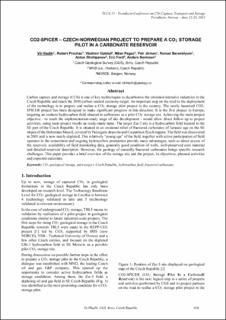| dc.contributor.author | Hladik, Vit | |
| dc.contributor.author | Prochac, Robert | |
| dc.contributor.author | Opletal, Vladimir | |
| dc.contributor.author | Pagac, Milan | |
| dc.contributor.author | Jirman, Petr | |
| dc.contributor.author | Berenblyum, Roman | |
| dc.contributor.author | Shchipanov, Anton | |
| dc.contributor.author | Ford, Eric | |
| dc.contributor.author | Nermoen, Anders | |
| dc.date.accessioned | 2021-09-30T07:43:16Z | |
| dc.date.available | 2021-09-30T07:43:16Z | |
| dc.date.issued | 2021 | |
| dc.identifier.isbn | 978-82-536-1714-5 | |
| dc.identifier.issn | 2387-4295 | |
| dc.identifier.uri | https://hdl.handle.net/11250/2786458 | |
| dc.description.abstract | Carbon capture and storage (CCS) is one of key technologies to decarbonise the emission-intensive industries in the Czech Republic and reach the 2050 carbon-neutral economy target. An important step on the road to the deployment of the technology is to prepare and realise a CO2 storage pilot project in the country. The newly launched CO2- SPICER project has been designed to make significant progress in this direction. It is the first project in Europe, targeting an onshore hydrocarbon field situated in carbonates as a pilot CO2 storage site. Achieving the main project objective - to reach the implementation-ready stage of site development - would allow direct follow-up to project activities, using main project results as ready-made input. The target Zar-3 site is a hydrocarbon field located in the SE part of the Czech Republic. It is situated in an erosional relict of fractured carbonates of Jurassic age on the SE slopes of the Bohemian Massif, covered by Paleogene deposits and Carpathian flysch nappes. The field was discovered in 2001 and is now nearly depleted. This relatively “young age” of the field, together with active participation of field operator in the consortium and ongoing hydrocarbon production provide many advantages, such as direct access of the reservoir, availability of field monitoring data, generally good condition of wells, well-preserved core material and detailed reservoir description. However, the geology of naturally fractured carbonates brings specific research challenges. This paper provides a brief overview of the storage site and the project, its objectives, planned activities and expected outcomes. | en_US |
| dc.language.iso | eng | en_US |
| dc.publisher | SINTEF Academic Press | en_US |
| dc.relation.ispartof | TCCS–11. CO2 Capture, Transport and Storage. Trondheim 22nd–23rd June 2021.
Short Papers from the 11th International Trondheim CCS Conference | |
| dc.relation.ispartofseries | SINTEF Proceedings;7 | |
| dc.rights | CC BY 4.0 | * |
| dc.rights.uri | https://creativecommons.org/licenses/by/4.0/ | * |
| dc.subject | CO2 geological storage | en_US |
| dc.subject | Czech Republic | |
| dc.subject | Hydrocarbon Field | |
| dc.subject | Fractured Carbonates | |
| dc.subject | Pilot Project | |
| dc.title | Co2-Spicer – Czech-Norwegian Project to Prepare a Co2 Storage Pilot in a Carbonate Reservoir | en_US |
| dc.type | Chapter | en_US |
| dc.type | Peer reviewed | en_US |
| dc.type | Conference object | en_US |
| dc.description.version | publishedVersion | en_US |
| dc.rights.holder | © 2021 The Authors. Published by SINTEF Academic Press. | en_US |
| dc.subject.nsi | VDP::Teknologi: 500 | en_US |

